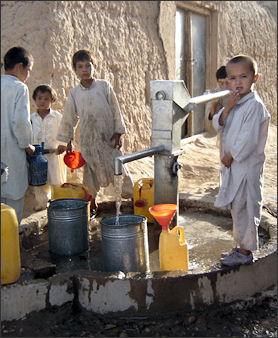URBAN LIFE IN THE DEVELOPING WORLD
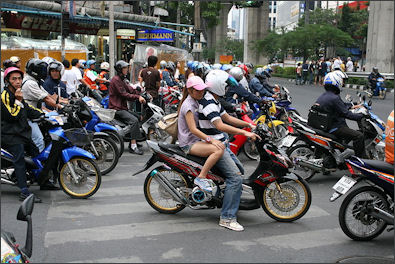
Motorbikes in Bangkok These days, for the first time in human history, there are more people living in the cities than in rural areas. The United Nations Human Settlements Program, estimates that by the year 2020 one quarter of the world’s population will live in so-called slums.
In developing countries there are often few zoning laws and if there are any they are ignored. Buildings are put up in a haphazard way often without much consideration to traffic, architectural aesthetics, urban infrastructure, and sewer and water lines.
Land ownership is sometimes very confused. It is not unusual for three or four parties to have claims on a piece of land, with none of them paying taxes. With no tax revenue there is no money for things like garbage pick up and education.
Urban agriculture provided 15 percent of the food consumed in cities. That figure could double by 2020.
Urban Mentality in the Developing World
Describing the mentality of urban areas, the Iraqi editor Saad al Bazzaz told the Atlantic Monthly: “In the city the old tribal ties are left behind. Everyone lives close together. The state is part of everyone’s life. They work at jobs and buy their food and clothing at markets and in stores. There are laws, police, courts, and schools. People in the city lose their fear of outsiders, and take an interest in foreign things.”
“Life in the city depends on cooperation, on sophisticated social networks. Mutual self-interest defines public policy. You can’t get anything done without cooperating with others, so politics in the city becomes the art of compromise and partnership. The highest goal of politics becomes cooperation, community, and keeping peace. By definition, politics in the city becomes nonviolent. The backbone of urban politics isn’t blood, it’s law.”
Migration from the Countryside to the Cities
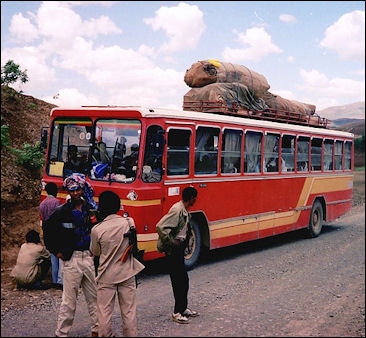
Bus in Ethiopia Urban populations are growing as rural people migrate to the cities to seek a better life. Many cities are being swallowed up by an influx of migrants from the countryside, who sometimes arrive at the rate of hundreds of thousands of people a year. The population increases in the cities are at rates that are often many times higher than population increases in the nation as a whole.
The urban planner Marc Weiss told National Geographic, “Cities are fundamental building blocks of prosperity both for nations and for families. They often account to 50 to 80 percent of a country’s GNP. “There’s the crazy notion that to deal with a city’s problems is to keep people out of them. But the problems for rural people are much more serious than those of the city.”
Migration to the cities has been described as “the most effective way for reducing the birthrate” and improving life. The poor generally have better access to education, health care, safe water, sanitation than they would in the countryside.
The World Bank has called migration “a powerful force for poverty reduction.” In 2005, 200 million migrants around the world sent home $167 billion. That is twice the size of the world’s development spending, and up from $31 billion in 1990.
Urban Migration Patterns
Sociologist call the migration to the cities the "bright lights effect." In most cases village men head off to cities to find work, leaving their wives and children behind to raise the children and take care of their land. The men often get menial jobs and send the money back. After the man establishes himself in the city he is joined by his wife and children, then nephews and uncles and other extended family members, who in turn establish themselves and are joined by their families and extended families.
The poorest of the poor usually don't migrate to the cities or abroad, rather it is people that can scrape together some extra money for the trip. Some people move to the cities to seek a better life. Other have been driven off their land as a result of soil depletion, erosion or disasters. Members of the later group are sometimes described as environmental refugees.
In many rural communities children are forced to move to the cities because family land is passed from father to oldest son and nothing has been left for them. In other communities, family property has been subdivided over generations to such an extent that there is not enough land to raise a crop for a family, let alone make a profit.
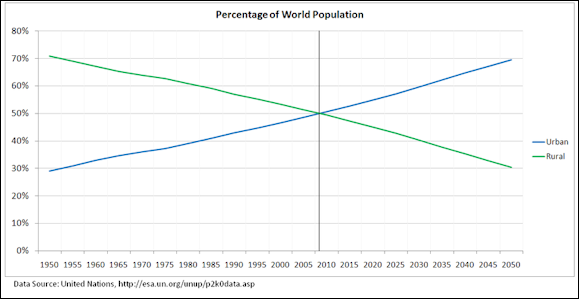
Percentage of world population in urban and rural areas
New Arrivals to the Cities
Many of the newcomers from the countryside initially live in shacks in squatters' areas or in neighborhoods occupied by people from their home village. With space becoming tight many of those that live in squatter communities often live in shacks built on ravines susceptible to landslides or low-lying areas susceptible to flooding.
Most new arrivals perform service jobs such as washing car windows on street corners or shining shoes, clerical work, construction work, various kinds of menial labor, or hand delivering messages in cities where the phones don't work very well.
Villagers often have a hard time adapting to city life. Survival is a day to day struggle. Men often end collecting bottles and cans or other recyclable materials, and sometimes women resort to prostitution. Some families start their day by waking up at four in the morning to scavenge through discarded fruit left outside markets, and make their living by selling what they find on the streets for about four dollars a day.
More than half of the children in these neighborhoods never get past the second grade and those that are in school often can't afford textbooks, and are so tired from their daily chores they have problems staying awake. To save money mothers often breast feed their children until they are two.
Squatter Communities Become Neighborhoods
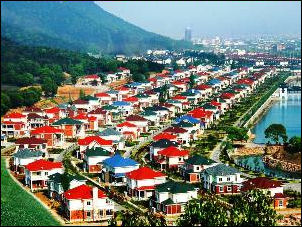
Many residential areas begin as squatters camps. As people move up in the world and get better jobs they build permanent homes that are illegally connected to the electric and water supplies. With the right to vote, they get politician to recognize their problems and build roads and other infrastructure projects.
There is little regard for zoning laws. Buildings are put open on public land supposedly reserved for parks and open spaces. Sometimes the government hires bulldozers to tear down the illegal structures.
Sometimes the government grants squatters ownership to the land they occupy. In some cases, peasants who had never owned anything more than a donkey are suddenly rich. People that worked hard to save up enough to buy some property are understandably upset when this happens.
Many people have been forced off their land because they have no official title to it. Many people don't now how to get land titles and those that do don't have the money to bribe bureaucrats to get the job done properly.
Water Shortages in the Cities
The shortage of water is a big problem in many cities. Water is sometimes turned on only a couple of times a day for about a half hour each time. People with money have special storage tanks to collect water during those times, which in turn allows them to have water around the clock. People without storage tanks collect water in jugs and buckets and often have to take bucket baths when the water is not turned on.
Many countries face serious water shortages, with the root of the problem being not so much shortages of water but overpopulation in places that are not really fit for human habitation. Water shortages are often local problems rather than national ones. Shortages are worse in places where there is little water or rain and lots of people.
tube well in AfghanistanWater tables are falling almost everywhere. Repeated drilling and well building has caused the water table to drop in some places by as much as six feet a year. Rich countries can compensate for shortages in some areas by building dams, importing food, tapping deep water aquifers, recycling wastewater, desalinated seawater. Poor countries are generally unable to do these things.
Urban Poverty
Currently about 1 billion people live in slums and shanty towns worldwide. The population of the world’s slums is expected to double to 2 billion in 2035.
Housing, water, sanitation, power and jobs are all in short supply in the developing world’s cities. Many of the urban poor are from the countryside. The informal economy is key to a lifestyle described as “informal survivalism.” Developing the informal economy is seen as key to providing jobs and services. In some places authorities have no real presence and people are left to fend for themselves and gangsters are in control.
What looks like a miserable life to people in the developed world — a low-paying job in a textile factory and home in a shanty town — can actually be alright to the people experiencing it. People living in these circumstances appreciate having a cooking stove, cell phone, television. Their meager pay allows them to buy a few things and gives them with the opportunity to provide education for their children and at least get as far as the first rung out of poverty.
Rural Life in the Developing World
A half century ago over 80 percent of the population worked the land. Today the figure is only about 40 percent. These days, worldwide, about as many people live in the cities as in the countryside. This is the first time in human history that this has occurred.
Most village farmers are small landowners with a few acres of land, on which they grow their own food, such as carrots, eggplants, pineapple and leaks. Even farmers that live within a two hour walk of the capital have no running water, plumbing, gas or electricity.
The average family income is about US$700 a year, roughly equivalent to the amount spent on a daughter's wedding. Families have typically five or six children. Some of them may migrate to the cities in the dry season to work as laborers.
A life spent in the fields gives rural people calloused hands, coppery skin and thick arms. These traits are often especially noticeable with women. A man with six goats, four oxen, two cows, one buffalo, and electricity in his home is considered a wealthy man by village standards.
In rural areas, time as measured by a clock has little relevance. People wake up at dawn and go about their chores until they are finished or its gets dark. In hot climates, people wake up early, often between 4:00 and 5:00am, and do their most arduous tasks before it gets too hot. During the hottest hours people rest and nap and resume their activities in the relatively cooler hours before sunset. As a rule people usually go to bed pretty early.
There is a strong sense of community in the villages. Much of village's property is shared and chores are done together with "laughter replacing speed."
On village life in China, Peter Hessler wrote: “In 2001, I began renting a home in the village, partly because I was curious about the region's history, but soon I realized that glimpses of the past were fleeting. Like most Chinese of the current generation, the villagers focused on today's opportunities: the rising prices for local crops, the construction boom that was bringing new jobs to Beijing, less than two hours away.
Rural Chores
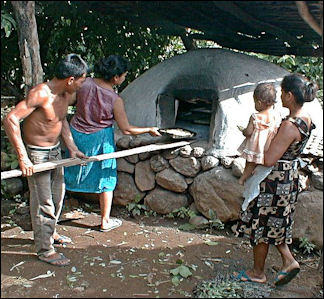
Making bread in Honduras Villages are often empty in the morning because everyone is out working in the fields or doing other chores. Before breakfast, a rural family usually feed their animals and collect eggs and milk. Water is tossed outside during the dry season to help keep down the dust. Treks often have to be made a mile or so outside the village to fetch firewood for cooking or to make charcoal and sometimes to collect water for bathing and drinking. During the rainy season water is collected off the roof of the house.
Today's villagers transport things they same way their ancestors did, with baskets on their backs attached to a strap wrapped around their forehead. Most things — firewood, empty bottles, coffee, corn, babies — are is carried around this way:
Villagers are very resourceful. Checkerboards are fashioned from old Masonite boards and beer bottle caps. Soccer balls are made from tin cans and large insects are tied to strings and kept as pets.
In some parts of the world almost every man has a machete, and lot of them carry it with them wherever they go. Farmers uses them to hack down bush and even trees to clear land for their slash and burn farming. Women dice their vegetables and perform other household chores with them. Old men and old women even use them as walking sticks.
Winter is often very quiet. There are not many chores to do other collecting firewood and water and preparing meals and people often spend most of their time indoors. Villagers often stay in bed until midmorning and they eat two meals a day instead of three.
Impact on the Countryside of the Migration to the Cities
As the rural population gets smaller as young people move to the cities in search of better education and jobs, the proportion of old people to young people in the countryside gets larger Young men that stick around sometimes become bachelor farmers because all the women have left.
In an attempt to reduce the number of people migrating from the countryside to the cities, governments have put more funds into rural development for things like village schools, clinics, and sewers. In some places craft and weaving schools have been set up for young men and women to give them a basic education and teach them skills they can use in their villages. Even so, there are so many village and rural communities out there that these programs affect a relatively small number of people.
Image Sources: Wikimedia Commons
Text Sources: New York Times, Washington Post, Los Angeles Times, Times of London, Yomiuri Shimbun, The Guardian, National Geographic, The New Yorker, Time, Newsweek, Reuters, AP, Lonely Planet Guides, Compton’s Encyclopedia and various books and other publications.
Last updated January 2012

